I agree with your statement completely. But the op’s question was how to cut RR iron. The video was an easy way to show a way of cutting it. I have used RR anvil in the past when I had to and it’s not ideal.Npace,yes,that is what folks commonly think of when they get a hold of RR rail.
It's a misconception,it mostly just Looks like an anvil(aka on blacksmithing resources as "ASO"-anvil-shaped Object
It works Very poorly as an anvil.An anvil's job is to oppose,and maximally Refract energy that your hammer-blow imparts.
To do that it must have Mass,and it must be maximally concentrated right under where you strike.The RR rail has very little mass,it's stretched out sideways,and that thin web underneath further ruins the effect Distributing,vs concentrating the energy.As a result it mostly vibrates and jangles
If you're up against it and Must use RR rail-use it Vertically,as long as you can,and sunk in a bucket of concrete if possible.
-
The BladeForums.com 2024 Traditional Knife is available! Price is $250 ea (shipped within CONUS).
Order here: https://www.bladeforums.com/help/2024-traditional/
You are using an out of date browser. It may not display this or other websites correctly.
You should upgrade or use an alternative browser.
You should upgrade or use an alternative browser.
It followed me home (Part 2)
- Thread starter Steve Tall
- Start date
Square_peg
Gold Member
- Joined
- Feb 1, 2012
- Messages
- 13,853
If you're up against it and Must use RR rail-use it Vertically
My first anvil was a piece of track stood on end. It wasn't bad except for having such a small working area.
And you're spot on about the web of the track ruining it as an anvil.
- Joined
- Dec 17, 2018
- Messages
- 1,196
Man, don’t even worry about the pedantry on this forum at all. Your track will work great for your purposes! It’s not like you are forging steel and need an actual anvil for all the heavy work you’re doing on it.I guess I wasn't thinking anvil in the way normal people do, didn't have any intention of trying to make one of those. Sometimes I just need a stout piece of steel to hammer something on (a very generic use of the word anvil), or as I wanted to do with some of this rail, a smallish piece of steel to use when setting teeth on crosscuts (also an anvil). Just used a severed piece of this rail (on its end) to support a one man crosscut where the helper handle pin needed to be driven out. It also, sitting upright on a piece of locust firewood, did a nice job of supporting an axe as I drove the handle out. Just little stuff...
My piece of track has stood up to the rigors of being gently tapped on with a cobblers hammer, the soft thud of a rubber mallet, and yes even some good strikes with a sledge to bang on a thing occasionally.
you’ll find it useful just how it is for all sorts of utilitarian purposes around the shop.
It’s ironic how someone posts a $500 antique axe on here and people will be like “I’d abuse it like a rented mule.” But if you post a piece of RR track and say that you’re going to use it to tap the handle out a head the response is like “God no, you can’t do that!!”, LoL
Have fun with your track it’ll be a suitable work surface for your small odd jobs.
Last edited:
- Joined
- Jul 25, 2017
- Messages
- 2,462
I want some track...i know for me, thats all i will ever need and need it for. Nothing pretty, just to prop something on and whack probably.
Now, if an anvil comes knocking...i never mind an upgrade, or level up.
Now, if an anvil comes knocking...i never mind an upgrade, or level up.
- Joined
- Feb 15, 2017
- Messages
- 942
Glad yall said something about standing it up on end,i used mine to peen the pin in a scraper awhile back and that worked tits.
- Joined
- Mar 12, 2011
- Messages
- 214
I could fit a piece in one of those flat rate priority mail boxes... probably need a wood frame to support the box from inside but I don't need all of that rail. Message me if interested.I want some track...i know for me, thats all i will ever need and need it for. Nothing pretty, just to prop something on and whack probably.
- Joined
- Dec 17, 2018
- Messages
- 1,196
Just got this 24” of sexiness from Owen’s axe and handle via Lamaca via Bushcrastsisyphus... I’m not sure exactly what happened but it’s bad ass! (Hope I don’t screw it up.)
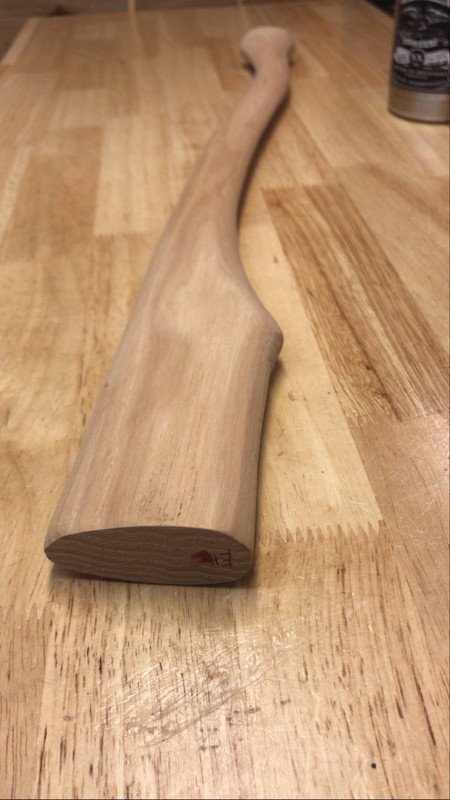

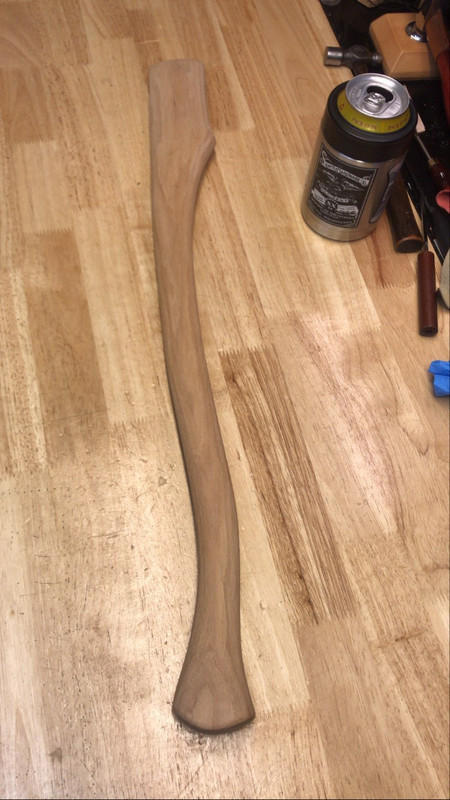
It’s their elite grade handle.



It’s their elite grade handle.
- Joined
- Mar 31, 2018
- Messages
- 1,875
Beautiful... Looks vintage. Quality!Just got this 24” of sexiness from Owen’s axe and handle via Lamaca via Bushcrastsisyphus... I’m not sure exactly what happened but it’s bad ass! (Hope I don’t screw it up.)



It’s their elite grade handle.
- Joined
- Mar 31, 2016
- Messages
- 1,927
if you do use it for forging, one thin i highly suggest is grind a flat in it
it's hard to straighten things against a convex surface.
oh and grind one of the ends flat as well. very useful
these are the main drawbacks i'v found.
at this level of budget, you can either have a large working surface or you can have rebound. cheap anvils have neither. they dent easily and are unhardened cast iron.
of course if you want to upgrade the track, you could always harden it if you build a big enough fire. high nickel steel's pretty good for wear resistance
it's hard to straighten things against a convex surface.
oh and grind one of the ends flat as well. very useful
these are the main drawbacks i'v found.
at this level of budget, you can either have a large working surface or you can have rebound. cheap anvils have neither. they dent easily and are unhardened cast iron.
of course if you want to upgrade the track, you could always harden it if you build a big enough fire. high nickel steel's pretty good for wear resistance
Last edited:
Square_peg
Gold Member
- Joined
- Feb 1, 2012
- Messages
- 13,853
of course if you want to upgrade the track, you could always harden it if you build a big enough fire
Weygers illustrates the method for hardening a track anvil in his 'The Complete Modern Blacksmith'.
- Joined
- Jul 31, 2017
- Messages
- 1,483
Weygers illustrates the method for hardening a track anvil in his 'The Complete Modern Blacksmith'.
https://archive.org/details/The_Modern_Blacksmith_Alexander_G._Weygers/page/n85
- Joined
- Dec 17, 2018
- Messages
- 1,196
Well this thing is useless, it has no base at all?!? 
Actually I got some cool burled up stumps of a plumb tree that have nice character. I also picked up a WWI leather strap and some rusty 1” tacks to make hammer/tool loops around it.
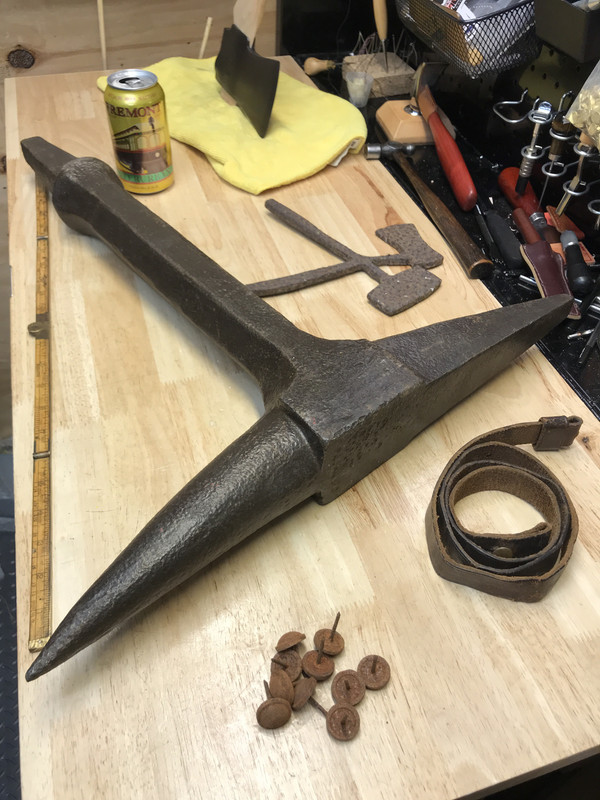
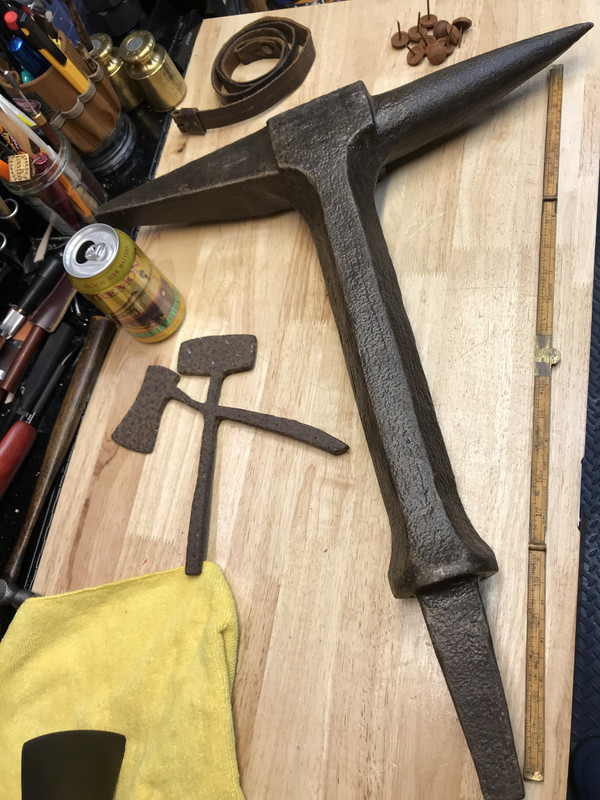
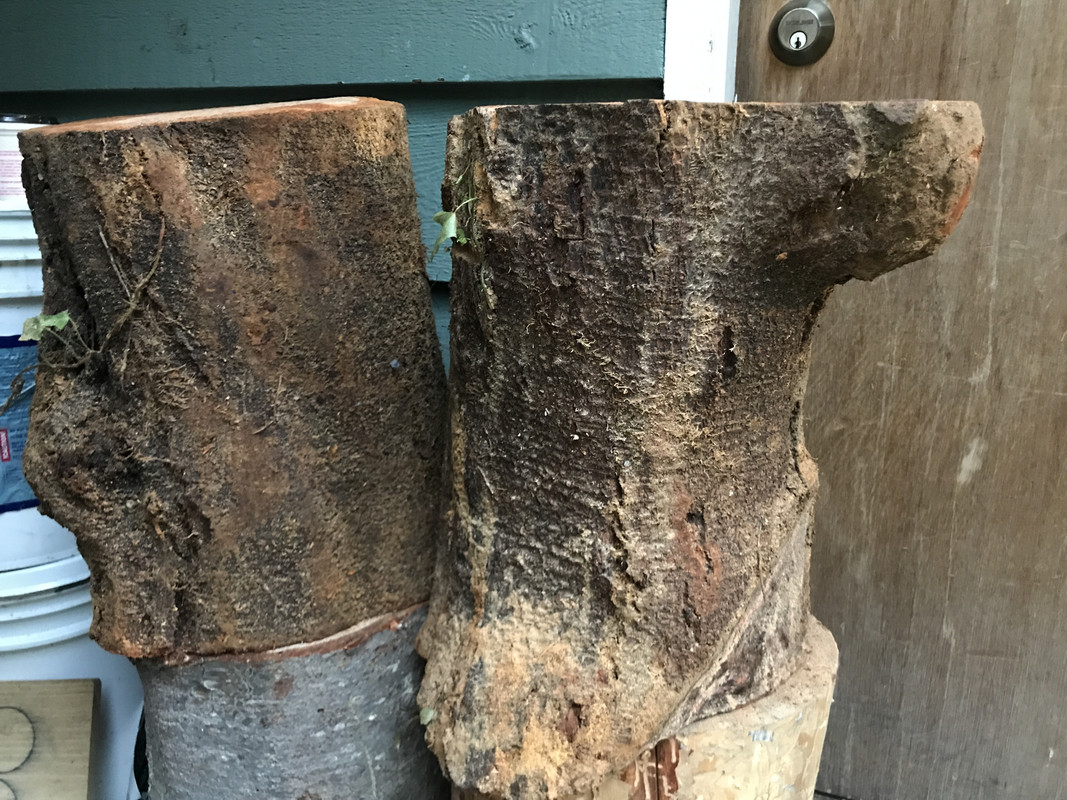
Oh yeah! I also found that little blacksmith made hammer and axe wall hanger.
Actually I got some cool burled up stumps of a plumb tree that have nice character. I also picked up a WWI leather strap and some rusty 1” tacks to make hammer/tool loops around it.



Oh yeah! I also found that little blacksmith made hammer and axe wall hanger.
- Joined
- Jul 25, 2017
- Messages
- 2,462
Well this thing is useless, it has no base at all?!?
Actually I got some cool burled up stumps of a plumb tree that have nice character. I also picked up a WWI leather strap and some rusty 1” tacks to make hammer/tool loops around it.



Oh yeah! I also found that little blacksmith made hammer and axe wall hanger.
Yes sir...you just levelled up lol!
Thank you for sharing and showing your stump anvil with some items for size comparison.


This is a project i am excited to watch as it develops and grows.
Thanks
- Joined
- Dec 17, 2018
- Messages
- 1,196
LoL. Thanks, I appreciate that! The anvil is 40lbs.Yes sir...you just levelled up lol!
Thank you for sharing and showing your stump anvil with some items for size comparison.
This is a project i am excited to watch as it develops and grows.
Thanksithinkverydeeply
Well this thing is useless, it has no base at all?
Good for you!This thing is Very useful!
It isn't an "anvil"(pedantry!I know you love it
As it's name implies it is an anvil-shaped stake,a bottom-tool.
It used to be a very important tool in any shop.The "beak",or rounded side is for welding and shaping sockets of all sorts,without it any socket work is a pain.
(i've had to build one as i needed it,and it was a lot of work and hassle,and of course will never be as handy as a factory tool).
The square-section counter is for shaping and truing-up of assorted square-ish recesses,like hinge-joints(where i at times sorely missed something very like it).
If of good quality,the top face of it will be at slightly under 90 degrees to the sides,so that you Can shape an accurate 90...
This tool has a very good base.Of course it's not meant to go into a "stump",it is sized and shaped to fit into a special recess in a swage block,or an iron-man...Sometimes in a hardy hole of an anvil,tho' it'd then have to be a dedicated anvil and set up lower than usual.
But the germane thing about it's general arrangement is that it's "body"'s Mass is arranged directly under where you'd be likely to strike it-the small flat face-and is about equal in section.That will make the energy transmit all the way through the tool,giving you the most return on your energy invested.
All that is just some very general pedantry...Forging is a very precise science,there's a Lot of thought and precision of method...
I know that i do go on and On in an nagging,and no doubt annoying manner...I do apologise for that...It's just that to Me it contains Lots of info that is very pertinent...
- Joined
- Apr 20, 2017
- Messages
- 1,001
T
That's great info! I think sunk in a stump it could be a great utility item, like the railroad sections. Perhaps not really for dedicated forging, but for the odd job I've wanted something like that a million times. I do need to pick up some RR for banging on, just need the right source. Was hoping to find some free.
The other thing I have for the task is a 13lb block of S7 that I got at Alro. I haven't come up with a way/chance to harden it. I did get it to turn black after a long application of heat, I'm not sure what state that is. They have nice big drops of all sorts of tool steel that would make good anvils.
Good for you!This thing is Very useful!
It isn't an "anvil"(pedantry!I know you love it,although it is called a "stake-anvil"(or more commonly a "beak"or "bick").
As it's name implies it is an anvil-shaped stake,a bottom-tool.
It used to be a very important tool in any shop.The "beak",or rounded side is for welding and shaping sockets of all sorts,without it any socket work is a pain.
(i've had to build one as i needed it,and it was a lot of work and hassle,and of course will never be as handy as a factory tool).
The square-section counter is for shaping and truing-up of assorted square-ish recesses,like hinge-joints(where i at times sorely missed something very like it).
If of good quality,the top face of it will be at slightly under 90 degrees to the sides,so that you Can shape an accurate 90...
This tool has a very good base.Of course it's not meant to go into a "stump",it is sized and shaped to fit into a special recess in a swage block,or an iron-man...Sometimes in a hardy hole of an anvil,tho' it'd then have to be a dedicated anvil and set up lower than usual.
But the germane thing about it's general arrangement is that it's "body"'s Mass is arranged directly under where you'd be likely to strike it-the small flat face-and is about equal in section.That will make the energy transmit all the way through the tool,giving you the most return on your energy invested.
All that is just some very general pedantry...Forging is a very precise science,there's a Lot of thought and precision of method...
I know that i do go on and On in an nagging,and no doubt annoying manner...I do apologise for that...It's just that to Me it contains Lots of info that is very pertinent...
That's great info! I think sunk in a stump it could be a great utility item, like the railroad sections. Perhaps not really for dedicated forging, but for the odd job I've wanted something like that a million times. I do need to pick up some RR for banging on, just need the right source. Was hoping to find some free.
The other thing I have for the task is a 13lb block of S7 that I got at Alro. I haven't come up with a way/chance to harden it. I did get it to turn black after a long application of heat, I'm not sure what state that is. They have nice big drops of all sorts of tool steel that would make good anvils.
The other thing I have for the task is a 13lb block of S7 that I got at Alro. I haven't come up with a way/chance to harden it. I did get it to turn black after a long application of heat, I'm not sure what state that is. They have nice big drops of all sorts of tool steel that would make good anvils.
That's Excellent,Fmont,good for you,the best way to go.
(and an absolutely Enviable source of drops...cool!!!).
S7 is of course an air-hardening alloy,and would require a pretty decent degree of heat.Black in color,as in below any visible,will not have done anything to it of curse,but this is what this steel is for-to remain tough even when very hot,like when used for rolling steel et c.
Here's a quick glance at what it'd take:S7 should be preheated at 1200 to 1300°F and raised to the hardening temperature of 1725°F, holding at temperature for one hour for each inch of greatest cross-section. Sections 2-1/2-in. or less should be quenched in still air. Upon reaching 150°F, the piece should be tempered without delay.
S7 is one of backyard smith's favorite alloys exactly because it it very tough without proper HT(used for chisels and punches that get too hot to maintain it's HT).
It is some lovely stuff,and will work very well entirely untreated(of course you don't know what state it Is in,but it just don't matter).
Recess it in a stump a bit so it doesn't walk about,and just use it.
What i'd do though is break,as in chamfer,all sharp edges.You can get fancy and create some varying radiused bevels,ranging from nothing to maybe 3/8" or a 1/2",sometimes can be useful.
That is to avoid mushrooming or chipping either your block,or your tool,Or nicking the work itself.
Now a Proper anvil(to be pedantic)needs to be crowned,a flat surface will have a tendency to raise Up what falls outside your blow,bending the thinner work/bouncing the thicker,but it's minutiae,you don't need to worry about it.(or if sometime you've really nothing better to do a couple hours with a flapper disc will give you plenty of crown).
A nice little chunk of such sexy alloy is all a guy needs for pretty much anything....
- Joined
- Dec 17, 2018
- Messages
- 1,196
Thanks! It’s cool man, I know anvils are your thing.
Good for you!This thing is Very useful!
It isn't an "anvil"(pedantry!I know you love it,although it is called a "stake-anvil"(or more commonly a "beak"or "bick").
As it's name implies it is an anvil-shaped stake,a bottom-tool.
It used to be a very important tool in any shop.The "beak",or rounded side is for welding and shaping sockets of all sorts,without it any socket work is a pain.
(i've had to build one as i needed it,and it was a lot of work and hassle,and of course will never be as handy as a factory tool).
The square-section counter is for shaping and truing-up of assorted square-ish recesses,like hinge-joints(where i at times sorely missed something very like it).
If of good quality,the top face of it will be at slightly under 90 degrees to the sides,so that you Can shape an accurate 90...
This tool has a very good base.Of course it's not meant to go into a "stump",it is sized and shaped to fit into a special recess in a swage block,or an iron-man...Sometimes in a hardy hole of an anvil,tho' it'd then have to be a dedicated anvil and set up lower than usual.
But the germane thing about it's general arrangement is that it's "body"'s Mass is arranged directly under where you'd be likely to strike it-the small flat face-and is about equal in section.That will make the energy transmit all the way through the tool,giving you the most return on your energy invested.
All that is just some very general pedantry...Forging is a very precise science,there's a Lot of thought and precision of method...
I know that i do go on and On in an nagging,and no doubt annoying manner...I do apologise for that...It's just that to Me it contains Lots of info that is very pertinent...
- Joined
- Dec 17, 2018
- Messages
- 1,196
Oh yeah. It’s going in a stump and it’s primary purpose is going to be setting my beer on it. 
The Forge is an ancient institution,crucial to the well-being of a community,and over countless centuries many funky mythical customs kind of settled over the place itself,and many of it's tools...
The hearth,the fire is held by many to be the Soul of the place,so one never spits in it,nor throws a cigarette butt,or anything of the sort.
The Anvil is considered to represent the Face of the entity,so one never Ever sits down on it...But beer i think is entirely appropriate!
The hearth,the fire is held by many to be the Soul of the place,so one never spits in it,nor throws a cigarette butt,or anything of the sort.
The Anvil is considered to represent the Face of the entity,so one never Ever sits down on it...But beer i think is entirely appropriate!
